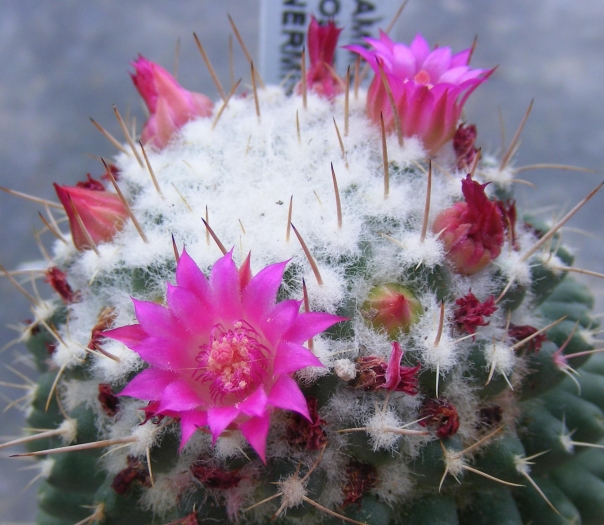Biznaga De Chilitos
(Mammillaria polythele)
Biznaga De Chilitos (Mammillaria polythele)
/
/

Dragonglow
Public domain
Image By:
Dragonglow
Recorded By:
Copyright:
Public domain
Copyright Notice:
Photo by: Dragonglow | License Type: Public domain | License URL: https://creativecommons.org/public-domain/ | Uploader: Dragonglow | Publisher: Wikimedia Commons | Title: Mammillaria_polythele_2.jpg | Notes: {{Artwork |Artist = {{Creator:Albert Eckhout}} |Title = {{pt|Mandioca}} {{en|Manioc}} |Year = {{other date|century|17}} |Technique = {{Oil on canvas}} |Dimensions = {{size|cm|93|93}} |Gallery = Nationalmuseet |Location = {{city|Copenhagen}} |Notes = |So |















Estimated Native Range
Summary
Mammillaria polythele, commonly known as Biznaga De Chilitos, is a cactus native to the arid and semi-arid regions of central and northern Mexico, where it grows in rocky habitats and desert scrub. This species is characterized by its cylindrical, erect stem that can reach up to 24 inches (61 centimeters) in height and 3 to 4 inches (7.6 to 10.16 centimeters) in diameter, with a dark green to blue-green coloration. The plant is adorned with pink flowers that bloom in the spring and summer, adding a splash of color to its surroundings. The flowers are quite showy, attracting pollinators such as bees and hummingbirds.
Biznaga De Chilitos is valued for its low maintenance requirements and its ability to thrive in hot, dry climates, making it a popular choice for rock gardens, xeriscaping, and as a container plant for patios and indoor settings. It requires full sun exposure to maintain its compact form and vibrant coloration. Watering should be minimal, allowing the soil to dry out completely between waterings to prevent root rot. It is best grown in well-draining soil, preferably a cactus mix or sandy loam. While generally pest-resistant, it can be susceptible to mealybugs and fungal diseases if overwatered. Gardeners should also be cautious of its sharp spines when handling the plant.CC BY-SA 4.0
Biznaga De Chilitos is valued for its low maintenance requirements and its ability to thrive in hot, dry climates, making it a popular choice for rock gardens, xeriscaping, and as a container plant for patios and indoor settings. It requires full sun exposure to maintain its compact form and vibrant coloration. Watering should be minimal, allowing the soil to dry out completely between waterings to prevent root rot. It is best grown in well-draining soil, preferably a cactus mix or sandy loam. While generally pest-resistant, it can be susceptible to mealybugs and fungal diseases if overwatered. Gardeners should also be cautious of its sharp spines when handling the plant.CC BY-SA 4.0
Plant Description
- Plant Type: Succulent
- Height: 0.5-2 feet
- Width: 0.1-0.4 feet
- Growth Rate: Slow
- Flower Color: Pink
- Flowering Season: Spring, Summer
- Leaf Retention: Evergreen
Growth Requirements
- Sun: Full Sun
- Water: Very Low, Low
- Drainage: Fast
Common Uses
Drought Tolerant, Low Maintenance, Showy Flowers
Natural Habitat
Arid and semi-arid regions of central and northern Mexico
Other Names
Common Names: Cactus
Scientific Names: , Mammillaria polythele, Mammillaria longispina, Mammillaria nigra, Mammillaria hexacantha, Mammillaria dolichocentra, Mammillaria obconella var. galeottii, Mammillaria dolichacantha, Mammillaria kelleriana, Mammillaria affinis
GBIF Accepted Name: Mammillaria polythele Mart.